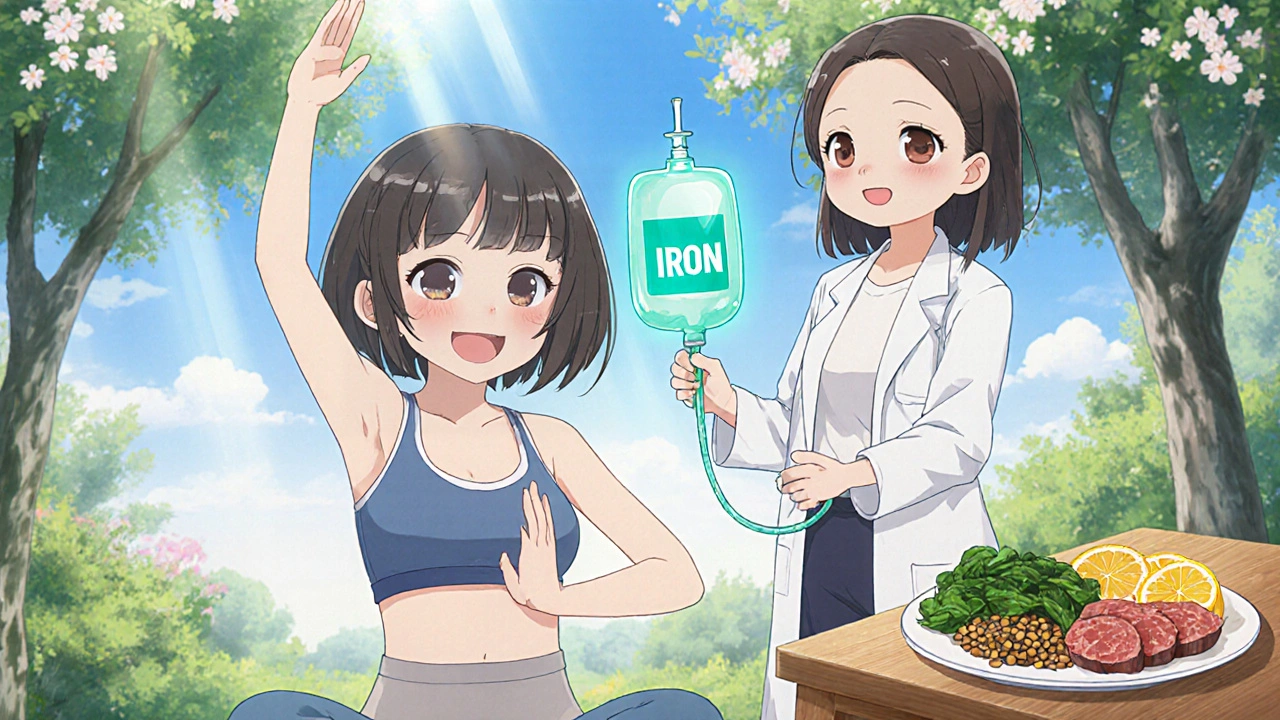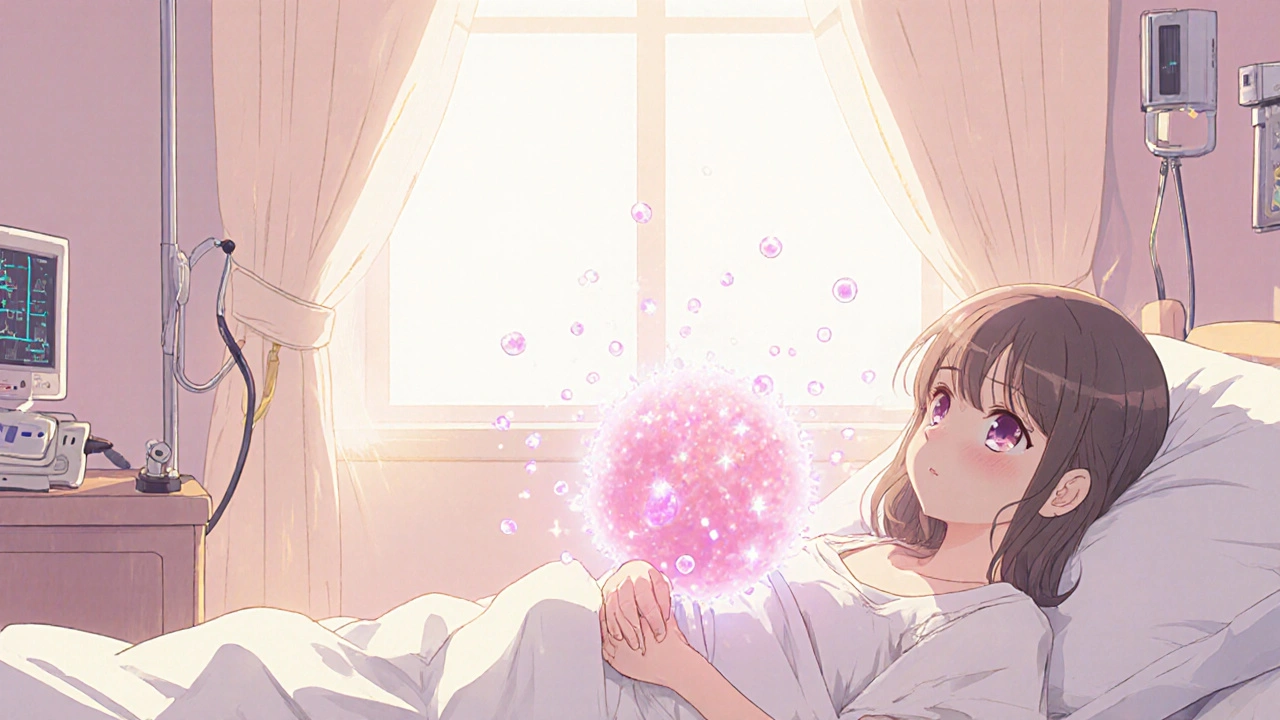Cancer-Related Anemia Assessment Tool
This tool helps identify potential causes of cancer-related anemia based on your symptoms and test results.
Likely Causes
Recommended Actions
Ever wonder why patients battling cancer often feel unusually tired, short of breath, or weak? The culprit is usually an under‑appreciated side effect: anemia caused directly by the tumor itself. Understanding how a growing tumor can sabotage the blood‑making system not only explains these symptoms but also opens doors to better treatment strategies.
What Is Tumor Growth?
Tumor growth is the uncontrolled proliferation of malignant cells that form a mass, invade surrounding tissues, and often trigger systemic changes in the body. As the mass expands, it releases a cocktail of bioactive substances, hijacks normal metabolism, and can even infiltrate bone marrow, setting the stage for anemia.
Defining Cancer‑Related Anemia
Cancer-related anemia is a type of anemia that occurs in patients with malignant tumors, arising from a combination of tumor‑derived factors, treatment side‑effects, and nutritional issues. Unlike anemia caused by simple blood loss, this form is multifactorial and often persists despite standard iron supplements.
How Tumors Drive Anemia: Key Mechanisms
The link between tumor growth and low hemoglobin isn’t a single pathway; it’s a web of interacting processes. Below are the most clinically relevant mechanisms:
- Inflammatory Cytokine Production - Tumors secrete interleukin‑6 (IL‑6), tumor necrosis factor‑α (TNF‑α), and interferon‑γ, which stimulate the liver to produce hepcidin. Elevated hepcidin traps iron inside macrophages, making it unavailable for red‑cell synthesis.
- Erythropoietin (EPO) Suppression - Healthy kidneys release EPO in response to low oxygen. Tumor‑derived factors can blunt this response, reducing the stimulus for red‑blood‑cell production.
- Iron Sequestration - Hepcidin not only blocks iron release but also down‑regulates ferroportin, the iron‑export channel on gut enterocytes, worsening functional iron deficiency.
- Bone Marrow Infiltration - Certain cancers (e.g., breast, prostate, lung) metastasize to the marrow, physically crowding out hematopoietic stem cells and impairing all blood lineages.
- Myelosuppressive Therapies - Chemotherapy and radiation damage rapidly dividing marrow cells, directly lowering red‑cell output.
- Chronic Blood Loss - Gastrointestinal tumors can cause occult bleeding, slowly depleting iron stores.
- Nutritional Deficiencies - Cancer‑related cachexia reduces intake of iron, vitamin B12, and folate, all essential for hemoglobin synthesis.

Clinical Impact of Anemia on Tumor Progression
Low hemoglobin isn’t just a symptom; it actively influences disease trajectory. Tumor hypoxia-caused by reduced oxygen delivery-can trigger the hypoxia‑inducible factor (HIF) pathway, leading to more aggressive tumor phenotypes, angiogenesis, and resistance to radiotherapy. Moreover, anemic patients often experience poorer chemotherapy tolerance, higher infection rates, and reduced overall survival.
Diagnosing Anemia in Cancer Patients
Accurate diagnosis starts with a thorough lab panel:
- Complete blood count (CBC) - focus on hemoglobin, hematocrit, and mean corpuscular volume (MCV).
- Serum ferritin and transferrin saturation - differentiate iron‑deficiency from functional iron deficiency.
- Serum hepcidin (where available) - indicates inflammatory sequestration.
- Reticulocyte count - assesses bone‑marrow response.
- Vitamin B12 and folate levels - rule out concurrent deficiencies.
Imaging (CT, MRI) may be warranted if marrow infiltration is suspected.
Managing Tumor‑Induced Anemia
Treatment must address both the anemia and its underlying tumor drivers. Strategies include:
- Control the Tumor - Effective oncologic therapy (targeted agents, immunotherapy) often reduces cytokine load and improves marrow function.
- Iron Supplementation - Intravenous iron bypasses hepcidin‑mediated blockades and quickly restores iron availability.
- Erythropoiesis‑Stimulating Agents (ESAs) - Recombinant EPO can boost red‑cell production, but use is limited to patients with hemoglobin <10 g/dL and not receiving curative intent radiation.
- Blood Transfusions - Reserved for symptomatic anemia or when rapid hemoglobin rise is needed for treatment eligibility.
- Nutritional Support - High‑protein diets, oral B12/folate, and vitamin D supplementation address cachexia‑related deficits.
- Anti‑Inflammatory Approaches - Agents like tocilizumab (anti‑IL‑6) are under investigation for reversing hepcidin‑driven iron lock‑up.
Regular monitoring every 2-4 weeks ensures timely adjustments.

Lifestyle and Supportive Strategies
While medical therapy is essential, patients can adopt everyday habits to mitigate anemia’s impact:
- Consume iron‑rich foods (lean red meat, lentils, spinach) alongside vitamin C sources to enhance absorption.
- Avoid excessive coffee or tea at meals, as they inhibit iron uptake.
- Engage in low‑impact exercise (walking, yoga) to improve circulation and stimulate erythropoiesis.
- Stay hydrated - blood volume maintenance aids oxygen transport.
- Discuss any supplement use with the oncology team to prevent interactions.
Key Takeaways
The relationship between tumor growth and anemia is a classic example of how cancer reshapes the entire body, not just the site of the primary tumor. By recognizing the distinct mechanisms-cytokine‑driven iron sequestration, EPO suppression, marrow infiltration, and therapy‑related myelosuppression-clinicians can tailor diagnostics and interventions that improve both quality of life and treatment outcomes.
| Cause | Typical in Cancer‑Related Anemia | Typical in General Anemia |
|---|---|---|
| Inflammatory Cytokines (IL‑6, TNF‑α) | High | Low to Moderate |
| Bone Marrow Infiltration | Common in metastatic disease | Rare |
| Iron Deficiency (dietary loss) | Functional deficiency due to hepcidin | Absolute iron loss (bleeding, poor diet) |
| Myelosuppressive Therapy | Frequent (chemo, radiation) | Uncommon |
| Chronic Blood Loss | Occult GI bleeding in GI tumors | Menstrual, GI ulcers, hemorrhoids |
Frequently Asked Questions
Why does anemia worsen cancer prognosis?
Low hemoglobin reduces oxygen delivery to tumors, activating hypoxia‑inducible pathways that make cancer cells more aggressive and less responsive to radiation and certain chemotherapies.
Can iron supplements alone fix cancer‑related anemia?
Usually not. Inflammatory hepcidin often blocks iron absorption, so intravenous iron or other strategies are needed alongside tumor control.
Are erythropoiesis‑stimulating agents safe for all cancer patients?
ESAs are limited to patients with hemoglobin below 10 g/dL and who are not undergoing curative radiation, because higher levels have been linked to thromboembolic events and possibly tumor progression.
How often should anemia be screened during cancer treatment?
A CBC every 2-4 weeks is standard, with additional iron studies if hemoglobin drops by more than 1 g/dL between visits.
What dietary changes help combat anemia in cancer patients?
Eat lean red meat, poultry, fortified cereals, leafy greens, and pair them with citrus fruits for vitamin C. Limit tea/coffee at meals and discuss any supplements with your oncologist.

Poornima Ganesan
October 18, 2025 AT 17:06First, let me clarify that tumor‑induced anemia is not a trivial side effect but a complex, multi‑layered pathophysiological process. The tumor’s secretion of interleukin‑6 (IL‑6) triggers hepatic hepcidin synthesis, which then sequesters iron within macrophages, effectively starving erythropoiesis. Simultaneously, tumor‑derived factors blunt the kidney’s erythropoietin response, reducing the primary hormonal drive for red‑cell production. Moreover, the invasive nature of certain malignancies allows direct infiltration of the bone marrow, displacing hematopoietic stem cells and impairing multilineage output. Chemotherapeutic regimens further exacerbate this by damaging proliferative marrow compartments, leading to a nadir in hemoglobin levels. Chronic occult bleeding, especially from gastrointestinal tumors, contributes an additional iron loss that is often overlooked. Nutritional cachexia, common in advanced disease, limits intake of essential micronutrients such as vitamin B12 and folate, compounding the synthetic deficit. The downstream effect is not merely fatigue; hypoxia induced by anemia activates the hypoxia‑inducible factor (HIF) pathway, promoting angiogenesis and aggressive tumor phenotypes. Consequently, anemia can paradoxically accelerate tumor progression, creating a vicious feedback loop. Clinical studies have demonstrated that patients with hemoglobin below 10 g/dL experience poorer responses to radiotherapy, likely due to reduced oxygen‑mediated DNA damage. Effective management therefore requires a dual approach: targeting the underlying malignancy while correcting the hematologic disturbance. Intravenous iron circumvents hepcidin‑mediated blockade, delivering bioavailable iron directly to the marrow. Erythropoiesis‑stimulating agents can be employed, but only after careful assessment of thromboembolic risk. Ultimately, the goal is to break the cycle: reduce inflammatory cytokine burden, restore iron homeostasis, and support erythropoietin signaling. This holistic strategy not only alleviates symptoms but may also improve overall survival. In summary, tumor growth triggers anemia through cytokine‑driven iron sequestration, marrow infiltration, and endocrine disruption, all of which intertwine to influence disease trajectory.
Emma Williams
October 22, 2025 AT 04:26The article gives a solid overview of how cancers can cause anemia.
Stephanie Zaragoza
October 26, 2025 AT 18:33It is essential to distinguish functional iron deficiency from absolute iron depletion; the former results from hepcidin‑mediated sequestration, whereas the latter stems from true depletion of iron stores. Consequently, a serum ferritin that is elevated, yet a low transferrin saturation, strongly suggests an inflammatory etiology. Moreover, reticulocyte counts provide insight into marrow responsiveness-if the count is inappropriately low, the marrow is likely suppressed by cytokines or direct tumor infiltration. Vitamin B12 and folate assays should not be neglected, as concurrent deficiencies can mask or exacerbate the anemic picture. Finally, when imaging reveals marrow lesions, a targeted biopsy may be warranted to delineate metastatic involvement.
Brian Van Horne
October 31, 2025 AT 09:40The interplay between tumor biology and erythropoiesis is undeniably intricate. Nonetheless, addressing the oncologic driver often yields the most pronounced hematologic improvement. Intriguingly, intravenous iron can act as a swift, albeit temporary, remedy.
Ayla Stewart
November 5, 2025 AT 00:46I appreciate the thorough breakdown of the mechanisms involved. It helps to see how each factor contributes to the overall picture. The mention of hepcidin’s role was especially clear. Managing both the cancer and the anemia seems key.
James Mali
November 9, 2025 AT 15:53Honestly, the piece reads like a textbook that forgot to add the human element. It’s all data, no soul.
Janet Morales
November 14, 2025 AT 07:00Well, that’s just the standard narrative they want us to swallow. In reality, the pharma industry pushes ESA usage to keep patients hooked on expensive treatments, not because it’s the best clinical choice. The side‑effects are downplayed, and the real risk of thrombosis is brushed under the rug. Don’t be fooled by the polished language.
Albert Fernàndez Chacón
November 18, 2025 AT 22:06While I understand the frustration, it’s important to weigh the evidence objectively. ESA therapy, when administered within guideline‑specified hemoglobin thresholds, has demonstrated quality‑of‑life benefits without a disproportionate increase in thrombotic events. The pharmacodynamics involve stimulating the EPO receptor on erythroid progenitors, thereby enhancing maturation. Nonetheless, patient‑specific risk profiling remains paramount.
Matthew Miller
November 23, 2025 AT 13:13Let’s keep the momentum going! Tackling tumor‑induced anemia is a battle worth fighting, and every intervention-from iron supplementation to precise oncologic control-counts as a win. Stay proactive, stay informed, and champion your health!
Liberty Moneybomb
November 28, 2025 AT 04:20Sure, but have you ever considered who profits from “keeping the fight going”? The whole medical apparatus thrives on chronic disease cycles, pushing endless treatments while the underlying power structures stay untouched. Wake up, people-there’s a bigger game at play.